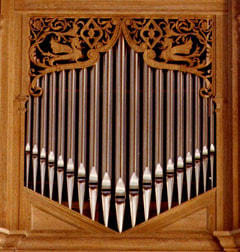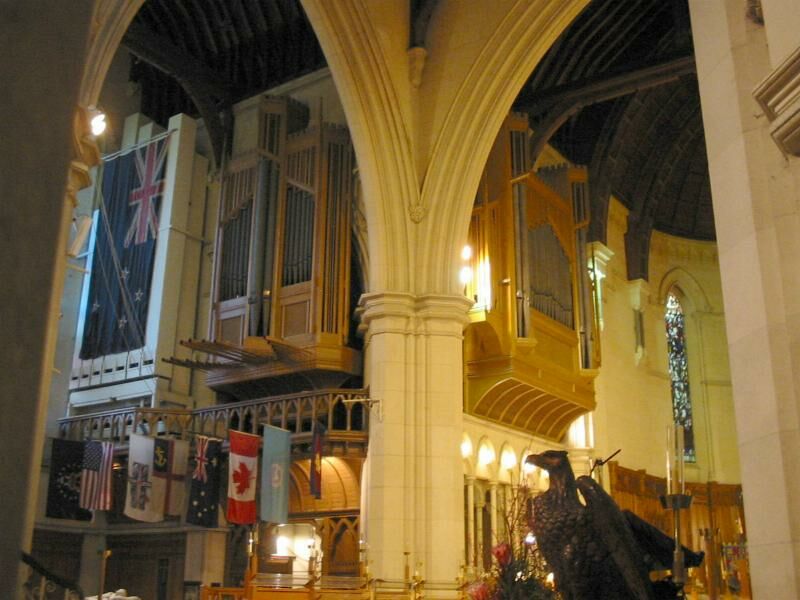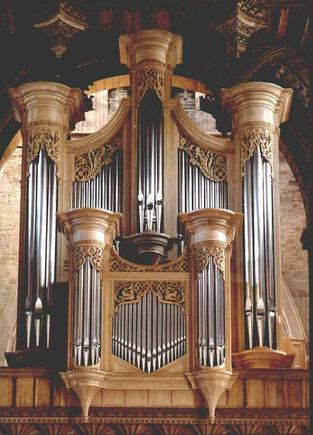Being a follower of fashion is nothing new, nor is it confined to clothing from Paris;
David Bridgeman-Sutton looks at the history of two organs .. . .
David Bridgeman-Sutton looks at the history of two organs .. . .
Tale of Two Organs. . . (continued)
|
One-hundred-and-thirty years after their completion, it is instructive to consider the further history of the Christchurch and the St David's organs. This reflects the musical fashions and economic conditions of their times.
A major reconstruction in 1926 by the original builder, Hill, resulted in an instrument of 54 speaking stops at Christchurch. The earlier 20th century liking for strong foundation work is evident in the organ now having three opens on the Great and the Diapason phonon on the Swell. However, Hill, unlike some other builders at the time, did not suppress upper work. so there were no losses in this respect. |
|
Hill characteristics of the time are seen elsewhere. The Corno Dolce appeared on a number of their organs as did the Cor de Nuit. The Unda Maris or flute celestes was introduced, as here, with some frequency. (The Eton College chapel organ, built seven years later, had two stops of this kind, one beating sharp, the other flat.) Hill’s orchestral stops were particularly fine: here these are exemplified by the addition of an orchestral oboe, a tuba and solo flutes to the choir. With new 32’ pedal doubles - a flue and a reed - and the completion of great and swell reed choruses to 16’ 8’ 4’ the instrument became a major cathedral organ.
|
The most notable of post-1926 additions are the horizontal trumpets and the pleasant case with its gothic detail (Pic. 2).
Apart from the addition of a pedal reed, there was no significant change at St Davids for 70 years. Willis’s sound workmanship withstood the effects of wear and damp, which was as well, for there were no funds for extensive work.
In 1953, Hill rebuilt the organ, with unchanged tonal scheme. The main feature of the work was the provision of a new case by the architect Alban Caröe: his work was marked, fortunately, by a characteristic elegance and, unfortunately, by a limited understanding of the work of organ builders.
A major and potentially disastrous change took place in 1980 when, despite the bubble-and-squeak mania being past the height of its fever, a positive section replaced the Willis choir. Some judicious additions were made elsewhere, including the provision of a swell mixture, but the extent of these was limited by the size of the case.
Harrison & Harrison’s rebuild of 2002 included extensive reworking and enlargement of the case, within which the Willis was extended to a four-manual instrument of 54 speaking stops. These included a complete reed chorus on the swell, a tuba and restoration of the Willis choir, the pipework of which had, happily, been stored in the Deanery. The fourth manual is a new positive named “West Choir”.
Apart from the addition of a pedal reed, there was no significant change at St Davids for 70 years. Willis’s sound workmanship withstood the effects of wear and damp, which was as well, for there were no funds for extensive work.
In 1953, Hill rebuilt the organ, with unchanged tonal scheme. The main feature of the work was the provision of a new case by the architect Alban Caröe: his work was marked, fortunately, by a characteristic elegance and, unfortunately, by a limited understanding of the work of organ builders.
A major and potentially disastrous change took place in 1980 when, despite the bubble-and-squeak mania being past the height of its fever, a positive section replaced the Willis choir. Some judicious additions were made elsewhere, including the provision of a swell mixture, but the extent of these was limited by the size of the case.
Harrison & Harrison’s rebuild of 2002 included extensive reworking and enlargement of the case, within which the Willis was extended to a four-manual instrument of 54 speaking stops. These included a complete reed chorus on the swell, a tuba and restoration of the Willis choir, the pipework of which had, happily, been stored in the Deanery. The fourth manual is a new positive named “West Choir”.
|
The new casework is handsome (Fig. 3). Also worthy of examination by visitors, is a smaller “case” which is in fact a memorial to the composer Thomas Tomkins, who was born in St Davids, where his father was organist.
In 1881, when the two organs were planned, the population of Christchurch was 32,000 and that of St Davids 2,000. By 2001, Christchurch had grown ten-fold and was a city of over 334,000: St Davids population had diminished by about 10% to 1800. In 1995, St Davids became a city by Royal Charter. Its small population means that officially it is still classified as a village! |
David Bridgeman-Sutton,
October 3, 2004
October 3, 2004
Credits:
- Detail from Figure 2.
- Supplied by and used with permission of the Dean & Chapter of Christchurch cathedral
- C.R.A. Davies, Durham, UK DH1 5LS




